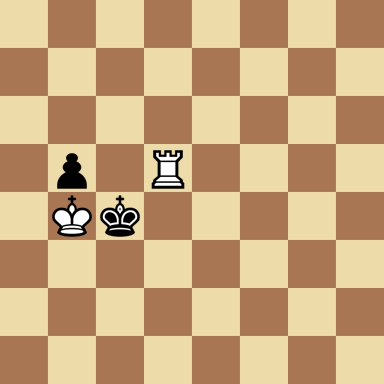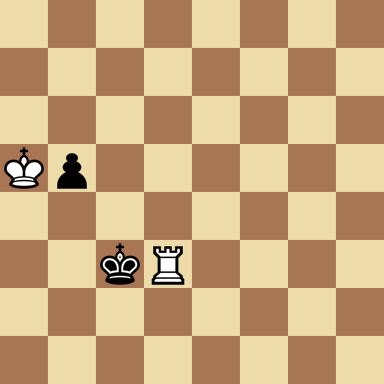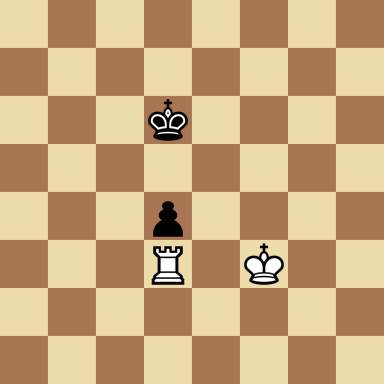|
ROOK VS PAWN Home | Traps | Openings | Endgames | Puzzles | Library | About me In Using Enemy Pawns, we saw the full study for the general case of Q-Kpk. In this article, we will look at R-Kpk and related endgames. There are three cases to consider: the pawn is on the (i) a-file, (ii) b-file or (iii) in the center. It turns out that (i) is a draw, (ii) wins if the rank of the black pawn is 3 or higher, (iii) wins if the rank of the pawn is 4 or higher. Personally, I find this quite surprising! We begin working with case (ii) and for the moment lets assume that the black pawn is not on the 7th rank (case is slightly more complicated, but it can be reduced). Look at the diagram below and imagine that white's king is out of the "rectangle" with opposite corners a1 and d5, say somewhere like h8. Then white win KR-k normally as if black didn't have the pawn. So, the question is how to get the king out of the box.  White to move: getting the king out of the rectangle. If black's king is on a5 or c5 then white win instantly with Kc3 or Ka3. Suppose black's king is not on c4. Then, white can play 1. Kc5 Kb4 (or 1... Kc4 or Kd4, doesn't matter), 2. Kc6 Kc5 3. Kb7! Now, this is where it gets hard. Suppose the blacks king is on c4 (diagram). 1. Rd4! Kb3! (if 1... Kc5 then 2. Rc4 Kb6 3. Rc5 and now black cannot play 3... Ka5 for 4. Kc3). Now, we triangulate: 2. Rd2 Kb3 (forced, black must stay "close" but not on the c4 square, otherwise white can play 3. Rd5 and black's king would not be on c4), 3. Rd3 Kc3 4. Ka5!  Black to move: position after 4. Ka5! Now: 4... Kb4 (if 4... Kc4, 5. Rd4+! Kc5 6. Kb4! and now black cannot play 6... Kc4 for 7. Rd5, or if 5... Kb4, 6. Rc4 Ka3 7. Rb4 Ka4 8. Kb6 Ka5 9. Kc7) 5. Rc3 Ka4 6. Rb3 Kb4 (if 6... b4 then 7. Kb6), so 7. Rd3! Here black have several options: if they play 7... Kc4, then we reduce this to a previously solved position, if 7... Kc5, then white can just play 8. Kb4 Kc4 Rd5! and again black must get off the c4 square, 7... Ka4 8. Rd4+ Kb4 (otherwise 9. Kb6 wins), 9. Rc4! and we have seen this before. Basically, black is cooked. This "Kc4" difficulty cannot be solved in the case of the a-file (its pretty easy to show its a draw). Now, lets suppose black's pawn is on b7 (just push all the piece back two squares). All that must be done now, is to force black to push the pawn. This is in fact pretty easy: we can assume that black's king isn't on a7 or c7, so white can play 1. Kc7 and 2. Kc8, if black follow with 2... Kc7 then 3. Kd8 forces black to push the pawn (ala the Trapdoor tactic). Note that there isn't any "Kc6" difficulty, we can allow the black king to escape if he pushes that pawn. Case (iii) is much easier. When we looked at Q-Kpk (Using Enemy Pawns, diagram 4), we have seen that white can separate the kings at the expense of the pawn advancing and the queen blocking the pawn. In case of the rook and separated kings, we cannot just have KRp2-k: the rook cannot just get out, the king must go behind it to take its place. But that would allow black to push the pawn again so having the black pawn on the 3rd rank isn't sufficient, we really need that 4th rank.  Black to move: final position, queen replaced with rook. A little paradox explained: if we pushes all the pieces 2 ranks forward and give white the move, its a draw (with queen). How did we make sure that didn't happen? Its a good question, read further if you want my explanation: (With queen, black cannot waste any tempos, not much "safe" squares out there). |
||||